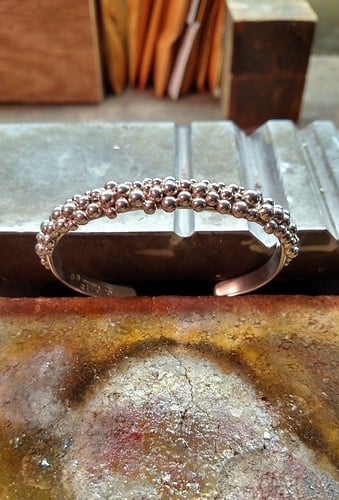In the process of fusing granulation to copper plated silver… does it matter what flux you use? The book i have says “auflux” is to be used. I just bought a borax cone and dish. And I already have batterns flux. If none of these are ok, whats so special about “auflux”?
Thanks for the help!
You’re going to have some problems if you’re trying to fuse metals with different melting points. Also, if the copper plating is a typically thin electroplate it will all burn to oxide before anything else happens.
If you’re working towards traditional granulation you need to add something which will alloy with the surface of the granules and base metal. Granulation is not really fusing, but rather colloidal soldering.
The granules are adhered with a mixture of an organic glue, which creates a reducing atmosphere under the flame, and a copper compound that is reduced so the copper will alloy with the surface molecules of the granules and base, allowing the surfaces to flow and join before the melting point of the metal is reached.
I’d assume that by “auflux” the author means a copper-rich solution of some type.
The ancient goldsmiths traditionally used finely ground chrysocolla, a copper ore, as the “gold glue” in granulation. “Chrysocolla” in ancient Greek means gold glue.
However, take all this with a grain of an appropriate salt, as my knowledge of granulation is academic rather than practical.
I do a very basic type of granulation and probably not really granulation at all. Each piece is applied one or two at a time which allows me to vary sizes of granules rather than one size or groups of sizes. I have a very random result.
I have seen granulations that were applied by picking up the granule with a fine round paint brush and attached with hide glue to the backing material. The piece was then fired in a kiln where the background and the granules “fused” together. Some very old Nordic, Viking, and Celtic work is exceptional in the use of granulation.
In my work each piece of granulation is made one at a time and then is attached by solder. Time consuming to say the least. But I am able to compose the different sizes of granules and their location on the piece in this way. I will also add gold to the mix of sterling.
Once again this isn’t granulation in any strict sense.
Don Meixner
I learned granulation with fine silver or gold. We didn’t use any flux only rabbit skin glue diluted with water. I know there are other organic glues that can probably be used, but this is what I was taught with so it’s what I know. Similar to fusing bezels or jumprings with only heat, instead with granulation, the rabbit skin glue is used to “adhere” the granules to the base until the metals fuse. The glue burns off and the metals fuse together.
Use a covered well heated mini kiln to heat the piece up to a red glow, then your torch to hit the top with heat until the metals fuse. It is a fine line between pre-fused - fused - melted mess so timing is very important. After cooled you need to check with a loupe to be sure every granule and band is fused to the base. It takes a lot of practice and many times the granules may only look fused. Check by hand that they don’t come off.
All your metals need to be cleaned well so there are no oils or contamination to the surface and only handled by tweezers once cleaned. Sand lightly or use some pumice and a little water to clean the surface. Flat backs should have a bent corner or edge to allow you to lift the piece up easily. The backs need to be prepped with yellow ochre to keep from melting before reaching fusing temp. Then set your wires and granules with glue, let dry, then fuse.
This is only a simplified description so follow the directions you have for all the specifics of what you are working with. Like everything else, with enough practice it works really well and is a lot of fun.
Ashlie,
I have posted a reply elsewhere but not sure whether it linked to your post, so I repeat it here. Auflux or Auroflux is simply a brand name for liquid flux recommended for use with either gold or silver. It is made in the UK and there is a data sheet ( https://www.cousinsuk.com/pdf/products/67_aa%20auroflux%20new.pdf ) that gives the chemical constituents. Hope this helps.
Yes, thank you so very much for taking time to help me. It’s more than highly appreciated! I will start playing around with it
In the book: “Theory and Practice of Goldsmithing” by Dr. Erhard Brepohl has a detailed chapter on granulating on pages 358-361. Fortunately, Hauser Verlag has prepared a reading sample that contains the entire chapter on granulation. You can find the article, unfortunately only in German here: https://www.thalia.de/shop/home/artikeldetails/ID43934303.html
The article can be translated easily with a goggle translator. Hope something helps. The Brepohl book is via Amazon also in English available
edmund
